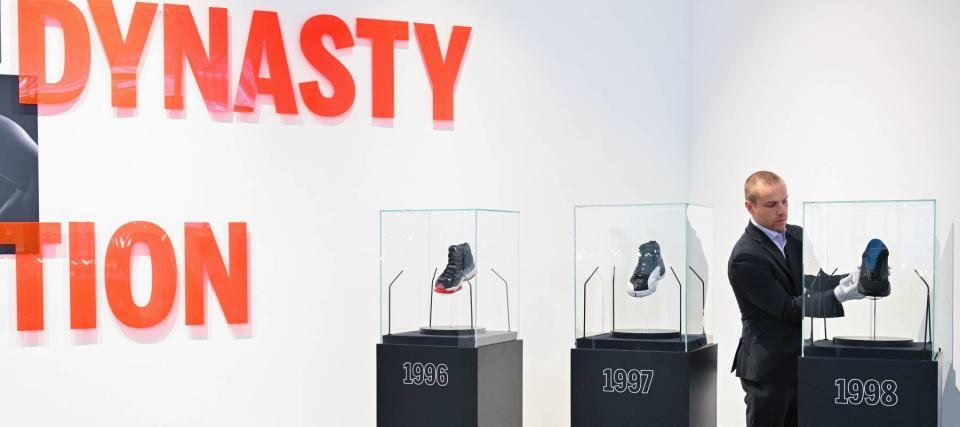
If you’re going to make a run for the riches, you could well do it in sneakers: investing in them, that is.
Bank of America’s 2024 Study of Wealthy Americans shows that millennials and Gen Zers with at least $3 million to invest are three times more likely to opt for alternative investments than older generations. In other words, they’ve shunned stocks to stock up on art, collectibles and crypto.
Don’t miss
In all, 83% of wealthy young Americans ages 21 to 43 own or are interested in an art collection compared to 40% of the wealthy overall. They’re investing in “blue chip art,” said Drew Watson, Bank of America’s head of art services (yes, there is such a title), in a Bloomberg interview.
“The fastest-growing segment of the art market is still post-[World War II] and contemporary art” from 1945 to the present, Watson added. It’s enough to conjure images of the young and rich throwing wet Benjamins at a canvas a la Jackson Pollock and hoping they stick.
The question is, do strategies like this paint a picture of financial gain?
Wealth beliefs across the generations
One characteristic that Gen Zers, millennials and baby boomers share, almost to the percentage point, centers on viewing their financial security as good or excellent: 75% for ages 21-43 versus 78% for those 44 and up.
A slim majority of the 1,000-plus survey participants also saw interest rates as no cause for optimism. A combined total of 52% predicted that rates would either stay the same or increase, a merited assessment given the Fed’s move to call off at least two of its three anticipated cuts this year.
The sharp divergence comes, then, with how the generations have chosen to build wealth. There’s distrust among millennials and Gen Z with the tried-and-true route, as 72% believe it’s “no longer possible to achieve above-average investment returns by investing solely in traditional stocks and bonds.” Only 28% of those 44 and older agree.
Younger generations thus have a pronounced affection for crypto, the report stated, though that flies in the face of “a headline fraud case in the burgeoning crypto industry” that involved the fall of FTX.
Meanwhile, Binance, the world’s largest crypto exchange, pleaded guilty in November to breaking anti-money laundering laws, unlicensed money transmitting and sanctions violations in a U.S. federal court — agreeing to pay astounding fines that totaled $4.3 billion.
Read more: Car insurance rates have spiked in the US to a stunning $2,150/year — but you can be smarter than that. Here’s how you can save yourself as much as $820 annually in minutes (it’s 100% free)
A (financial) appreciation of collectibles
With art and vintage items, the collection attraction is understandable given how it also provides a consumerist buzz.
After all, which is more gratifying, and downright fun? Owning 1,500 shares of General Motors, worth about $68,000? Or snagging a GM throwback — say, a 1960 Chevy Corvette two-door convertible just like the one gracing the cover of Bruce Springsteen’s memoir — that currently fetches an average of $69,200?
As for whether a collectible-based strategy can build wealth, there’s no way to know definitively, especially when value is so speculative (a characteristic of crypto as well).
Maybe that Corvette would’ve made for a turbocharged investment if you bought one new for $3,872, the price cited by JD Power. Still, with inflation, that’s $39,900 today, calculations from the Minneapolis Fed show. That equals a return below 2x over 64 years and, to borrow from Boss parlance, not exactly born-to-run stuff.
Compare that to the adjusted-for-inflation returns of the S&P 500. According to Macrotrends, a 1960 investment of about $600 would be worth $5,470 today: a return of more than 9x.
As with crypto, hitting the jackpot on a sought-after item is often a matter of luck and timing, a tricky proposition at best. Keep in mind as well that the IRS taxes the sale of collectibles at a rate of 28%, a fact of financial life many young wealthy folk could easily miss.
But all this hasn’t stopped the youthful and rich from snatching up watches, jewelry and wine/spirits, as those rank at the top of their lists; they’re also partial to rare automobiles, antiques and sneakers. Gen X and older collectors gravitate toward coins, jewelry and watches.
Now let’s return to those sneakers: You could cash in big time or get ripped off, depending on whether you’re buying or selling, knowledgable or gullible.
Nike Air Jordans are especially coveted, and an eBay seller is currently asking $1 million for a pair of Jordan 1 retros. These multi-color beauts fetched $135 when released in 2010, but another pair recently sold on StockX for $1,281.
The lesson is clear: Be careful around those who would sell you their sole.
What to read next
This article provides information only and should not be construed as advice. It is provided without warranty of any kind.

